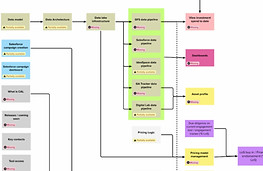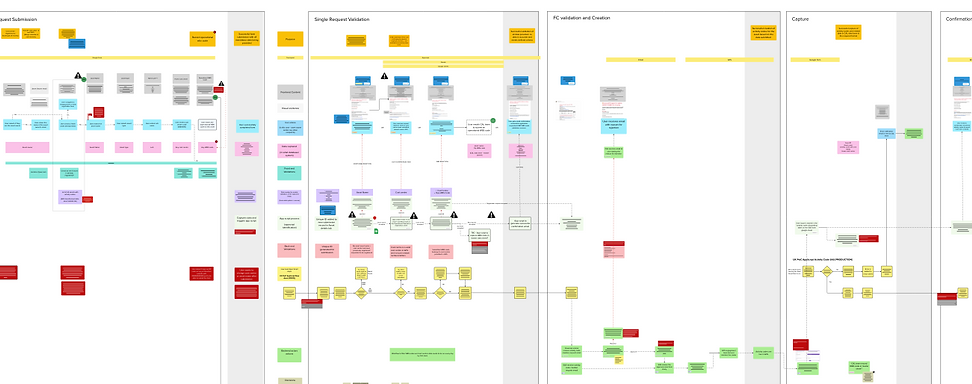
Enabling PwC teams to recognise commercial success from their technology assets
Commercial Asset Lifecycle
Problem
PwC is investing heavily in technology as part of their strategy. Although they have a well-established method for measuring the commercial success of their people services, they lacked a consistent method for measuring the commercial success of their technology assets and related services.
Brief
To design and implement a new service that enables PwC staff to seamlessly record and track commercial data for technology assets and recognise their commercial success.
Approach
This brief, unlike many big transformation projects, originated as grassroots effort within the organisation, set out to assess the feasibility, viability, desirability, and sustainability of a potential solution to the identified problem.
Due to the grassroots nature of the effort, the project team faced several challenges in ensuring effective delivery and adoption of the service. However, by employing a test and learn approach, the team was able to successfully demonstrate the impact of the service.
This case study highlights my involvement as a service designer in a multidisciplinary team of 5, across the entire development lifecycle of the service:
1. Scoping the solutions
2. Designing feasible and viable solutions
3. Developing a business case for the solution
4. Developing the solutions
5. Delivering the solution to users
6. Managing change and improving the solution
Solutions
As a part of the end to end service, I enabled the team to deliver the following solutions -
-
Service Guidance (1.1): For users to understand the purpose of the service and how to use it
-
New process and digital analytics product: For users to track market activity
-
New processes (1.2): For users to record financial transactions
-
New Data Infrastructure: To bring together all key data recorded in various enterprise systems
-
New digital analytics product (1.3): For users to track end to end commercial data
1.1 Service Guidance

1.3 New digital analytics product

1.2 New processes


Impact
The delivery of the service along with its component solutions, was able to generate significant impact for the firm:
Direct Impact:
Users: 200+ users across the firm, organically acquired without top-down incentives
Commercial: £25 million revenue recognised that was previously impossible to recognise
Technology: Data from 4 enterprise systems integrated, first ever integration of this scale within the firm
Enabled Impact:
Business: Firm wide metrics to recognise technology revenue changed - 5 new KPIs introduced
Operations: Operational changes to meet business goals enabled in 3 business units
Education: Increased awareness about the importance of commercial success from technology
Scoping the solutions
To make the large scope manageable, I conducted a 2 day long scoping workshop with business stakeholders and the project team. By bringing together this group of people, I -
-
Defined the overall business goal and business objectives through contextual deep dives
-
Co-designed the ideal (to-be) service (2.1) based on the business objectives. Using this service concept, I identified new and existing solutions, and opportunities for improvement.
-
Categorised the service into its component solutions (2.2)—new digital products, data infrastructure, processes, and communication—and prioritised the development of these solutions by co-creating a dependency map (2.3)
-
Defined the minimum viable versions of the solutions and identified the necessary technical capabilities for their development, while documenting assumptions made about the users along the way.
2.1 To-be service mapping

2.2 Solutions

2.3 Solutions dependencies

Designing feasible and viable solutions
A team of engineers, product managers, and UX designers were assembled to rapidly develop the minimum viable solutions (MVS) with a focus on discovering the feasibility and viability of developing these solutions.
To ensure the end-to-end service was designed such that it could be feasibly and viably delivered, I organised and led team workshops that enabled the delivery team to:
-
Structure and share insights (3.1) from the discovery, and classify these into—people, systems, processes, and data (3.2)
-
Co-design a feasible version of the end-to-end service, mapping considerations, decisions, and actions to ensure holistic service development (3.3)
-
Prioritise actions and create a robust delivery roadmap for the solutions in collaboration with the product manager (3.4)
3.1 Sharing insights

3.2 Classifying insights
_edited.jpg)
3.3 Co-designing the service
_edited.jpg)
3.4 Prioritisation and roadmap development

Developing
a business case for the service
In tandem with building the MVSs, I developed a comprehensive business case to secure funding for solution delivery. Some of my key activities included:
-
Mapping solutions to the business changes they enable and the business benefits they intend to deliver (4.1)
-
Designing a future state operating model to illustrate the resources needed for service delivery and maintenance. (4.2)
-
Developing cost estimates for various solutions
The business case successfully secured £1 million in funding for the financial year.
4.1 Benefits mapping

4.2 Operating model

Developing
the solutions
I played a key role in the agile development of each solution, ensuring that user-centered and service design thinking was integrated into the design, development, and delivery. Key activities included:
-
For new processes: Creating end to end service blueprints (5.1) to drive the roadmap, data design, technical discovery, development, front end content and testing
-
For new digital analytics products: Mapping jobs to be done for multiple stakeholders (5.2) to drive user story creation, data visualisation, wireframing (5.3), high fidelity prototyping and user testing
-
For service guidance: Creating information architecture flows to inform content design
5.1 Service blueprinting

5.2 Jobs to be done

5.3 User stories

5.3 Wireframing

Delivering the solutions to users
After launching the minimum viable solutions -
-
I drove adoption across six business areas by engaging with change agents, uncovering key user, stakeholder and business insights (6.1), and identifying implementation challenges due to existing incentive models and operating structures.
-
I also led the development of an analytics solution to track user adoption (6.2), providing quantitative evidence to support our qualitative findings.
-
By sharing these insights, I enabled user-centered service improvements and influenced operational changes across the firm
-
I made a case to the management board of PwC UK to change firmwide Key Performance Indicators (KPIs) to better incentivise people to drive change
This led to a notable increase in adoption, with 200+ new users, and a significant shift in the six business areas towards achieving business objectives.
6.1 Insights mapping

6.2 Measuring adoption and service outcomes

Managing change and improving the solution
During the delivery of the service, the organisation underwent several changes such as platform migrations and management shifts, which meant the service had to adapt accordingly.
I led the continuous design and delivery of the service using agile methods, developing the various products and services to achieve scale and a state of maintenance. Some key projects I worked on include:
-
Transitioned two services to new platforms, successfully enhancing performance and user experience.
-
Identified and addressed the needs of a new user group, resulting in the creation of a tailored product.
-
Strategically split one service into two distinct services to better target user needs and improve functionality.
-
Created a comprehensive offboarding service to ensure smooth transitions and maintain user satisfaction